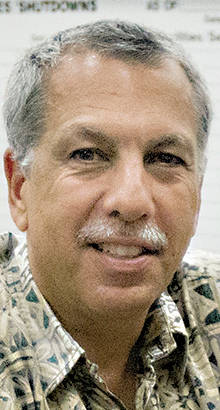We CAN improve health care

Changing the health care landscape is a daunting task, but our community has come together in an effort to alter the course of health care for the people of East Hawaii.
ADVERTISING
To do so, Community First, a local nonprofit organization under the leadership of Barry Taniguchi and others, organized a collaborative group named Community Action Network, or CAN. The focus of CAN is to bring together East Hawaii community stakeholders to collaborate and work together to find solutions to connect the medical and social resources in East Hawaii and better serve our residents and community.
In my roles as fire chief and Civil Defense administrator, I have seen the health care issues of our community unfold and grow through the years. I have seen our community members struggle with their health and struggle accessing appropriate resources when they needed it. From some of my prior experiences (tropical storms, lava flow, disease outbreak, etc.), I also witnessed how organizational plans and preparations might not match capabilities needed in reality.
Now, in my role as CAN’s steering committee chairman, our goal will be to “match” and coordinate the “care connection” capabilities with reality across our East Hawaii community.
Throughout the country, patients with complex health care needs account for a high percentage of annual medical costs. Many people, especially those with difficult medical and social challenges, are unable to manage their care on their own and ultimately end up in the hospital or emergency room multiple times. Some of these hospital admissions or emergency room visits could be avoided by connecting these patients to the appropriate resources in our community. Care managers, patient navigators, care coordinators and community health workers all try to solve this problem.
The people who work in these “care coordination” types of positions improve patient care and outcomes by helping patients and caregivers access and manage medical and social services. For instance, many people skip doctor appointments because they lack access to transportation; many people have behavioral health needs but are uncertain how to get help; and others have multiple chronic conditions that they do not know how to manage.
Care coordinators get these types of people to the right resources at the right time to overcome barriers in order to decrease inappropriate or unneeded visits to the hospital or emergency room. Given the complexities that medical and social service organizations face in trying to best serve the needs of complex patients, most organizations have created their own care/service coordination roles. Unfortunately, this has resulted in differences in role definitions, processes and communication lines which have caused confusion in how to coordinate efforts across organizations.
The critical importance of these issues is becoming clear as we realized health care costs cannot be successfully addressed solely by the medical system. We must work together as a community to create a better system of care. We must break down the silos in our organizations and agencies to provide seamless coordination within our own community’s system of care if we want to provide the resources to help our community members in a timely manner.
I believe in doing so, we actually will improve the quality of life of all the people of our community. My thoughts are that improved coordination will have impact far beyond just health matters and will address some of the social determinants that make life harder than it has to be in our community.
In order to succeed in its efforts, CAN created the Community Care Improvement Team to better understand the gaps in care through case studies. The CCIT is a multidisciplinary team of community stakeholders who will come together to understand the complete picture of what is and is not working in East Hawaii’s medical and social coordination.
To further advance the CCIT efforts, a care coordination summit is being planned in Hilo at the Aupuni Center from 8:30 a.m.-1 p.m. Oct. 3 under the leadership of Martha Yamada and Karen Teshima. This summit will assemble case managers, outreach workers, community health workers, care and patient coordinators, patient navigators and their leaders to better understand how to access the resources within their respective organizations and agencies, and to coordinate between each other. If you are in a role such as this and interested in attending this summit, please reach out to tom.spradling@navvishealthcare.com for more information.
As I said before, altering the course of health care in East Hawaii is daunting, but can we do it? I believe we CAN.
Darryl Oliveira is chairman of Community First’s Community Action Network. Oliveira previously served as the administrator for Hawaii County Civil Defense and fire chief of the Hawaii Fire Department.
This column was prepared by Community First, a nonprofit organization led by KTA’s Barry Taniguchi and supported by a volunteer board of local community leaders. Community First was established in 2014 to help the community respond to the health care cost crisis and support initiatives that change health care from just treating disease to caring for health. To learn more about Community First visit CommunityFirstHawaii.org.


